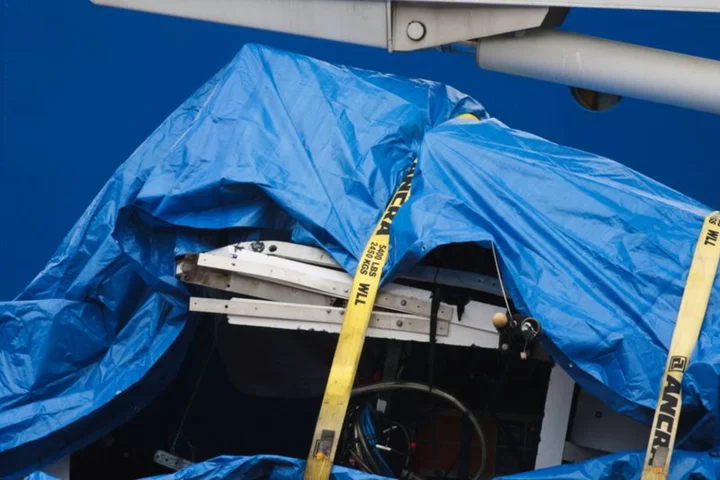By Ismail Shakil and Steve Gorman
OTTAWA (Reuters) -Debris from the tourist submersible destroyed in an implosion that killed the five people aboard were recovered along with presumed human remains and brought ashore on Wednesday for examination, the U.S. Coast Guard said.
The shattered remnants of the Titan, destroyed while diving to the wreck of the Titanic, and what were believed to be human remains were carried to port in St. John's, Newfoundland, Canada, about 400 miles north of the accident site, by the Canadian-flagged vessel Horizon Arctic, according to the Coast Guard.
The evidence will be transported by Coast Guard cutter to a U.S. port for analysis and testing by a marine board of investigation convened this week to conduct a formal inquiry into the loss of the Titan, the agency said.
U.S. medical professionals also "will conduct a formal analysis of presumed human remains that have been carefully recovered within the wreckage at the site of the incident," the Coast Guard statement added.
The nature and scope of the remains were not specified.
Video from the Canadian Broadcast Corp showed what appeared to be the nose of the submersible and other shattered fragments wrapped in white tarp pulled up by a crane from the deck of the Horizon Arctic on Wednesday morning.
Footage also showed a shattered piece of the Titan's hull and machinery with dangling wires being taken off the ship at St. John's, where the expedition to the Titanic had begun.
Examination of the debris is expected to shed more light on the cause of the catastrophic implosion that shattered the Titan on June 18 as the 22-foot vessel carried five people on a voyage to the century-old shipwreck of the Titanic in the North Atlantic.
Canada's Transportation Safety Board has opened its own investigation.
Fragments of the submersible, which had lost contact with its support surface ship about one hour and 45 minutes into a two-hour dive, were found littering the seabed about 1,600 feet (488 meters) from the bow of the Titanic wreck four days later.
The discovery by a robotic deep-sea diving vehicle scrounging the ocean floor more than 2 miles down ended a multinational search that captured worldwide media attention and sealed the fate of the five people aboard.
Among the dead was Stockton Rush, the submersible pilot and CEO of U.S.-based OceanGate Expeditions, which owned and operated the Titan. Also killed were the British billionaire Hamish Harding, 58; Pakistani-born businessman Shahzada Dawood, 48, and his 19-year-old son, Suleman; and 77-year-old French oceanographer Paul-Henri Nargeolet.
The accident has raised questions about the unregulated nature of such expeditions and the decision by OceanGate to forego third-party industry review and certification of Titan's novel design.
"Our team has successfully completed off-shore operations, but is still on mission and will be in the process of demobilization from the Horizon Arctic this morning," Pelagic Research, which operates a robotic vehicle used in recovering the debris, said in a statement.
(Reporting by Ismail Shakil in Ottawa and Steve Gorman in Los Angeles; editing by Deepa Babington and Leslie Adler)

